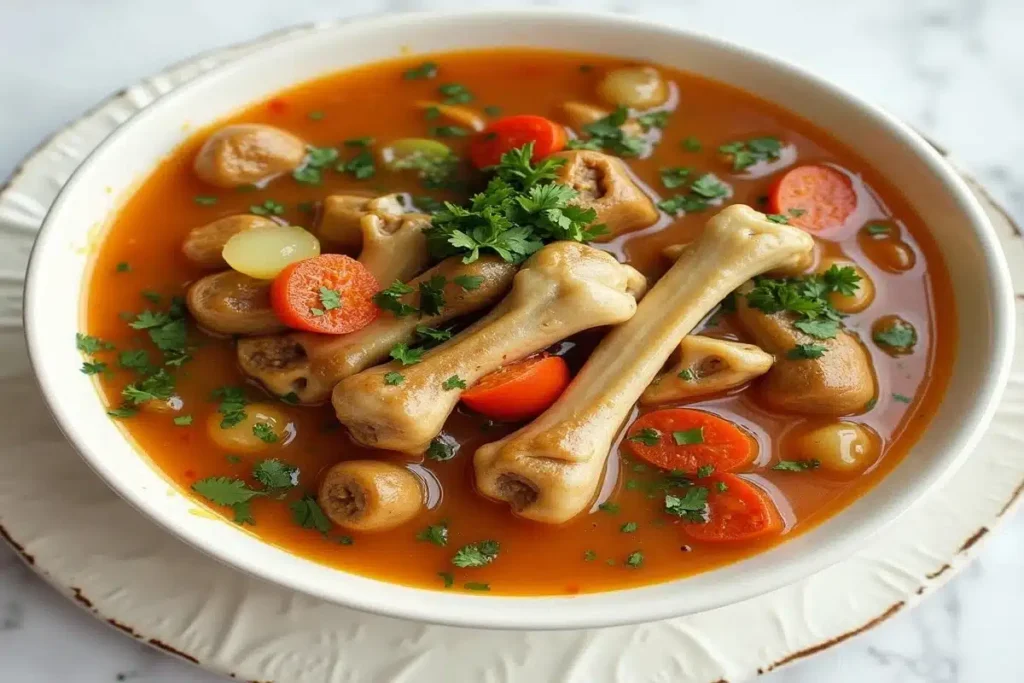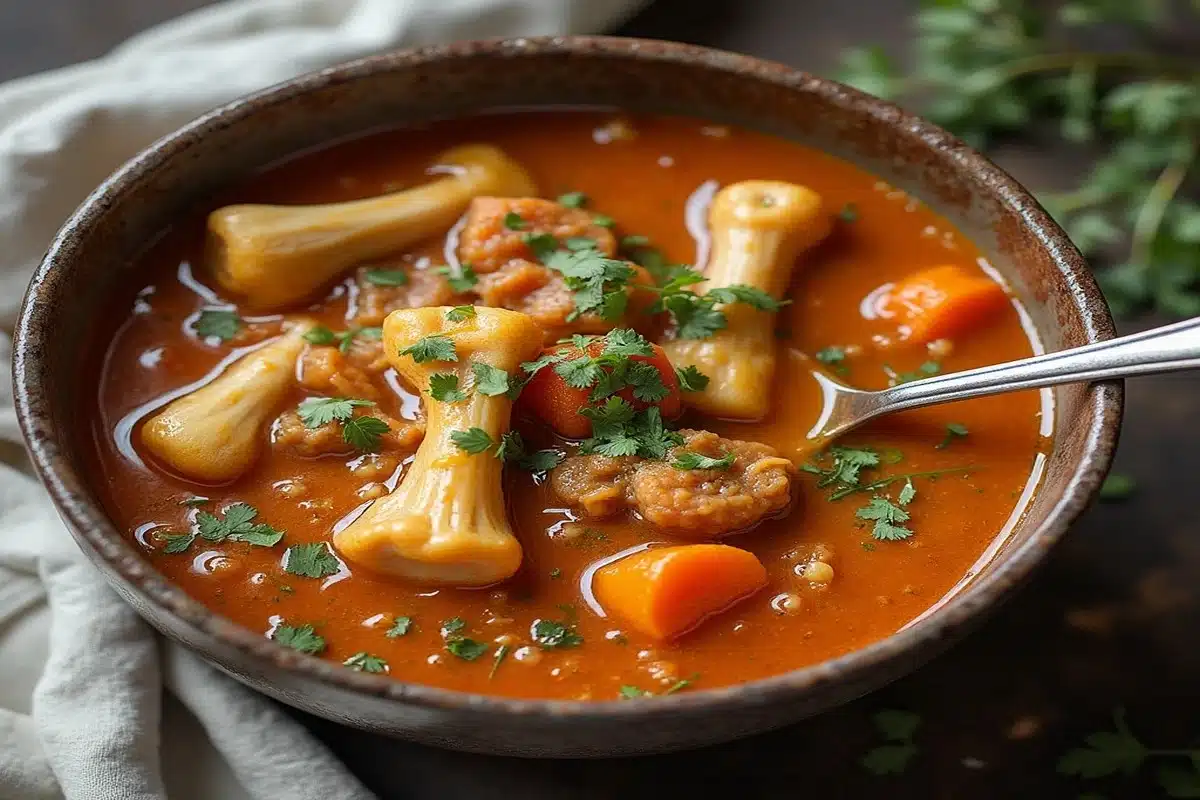If you’ve ever wondered what a soup bone is or how to get the most flavor out of one, you’re in the right place. A soup bone is a hidden gem in the culinary world, offering incredible depth of flavor and nutrition for your soups, broths, and stews.
This comprehensive guide will help you learn everything there is to know about soup bones – from choosing the right bone to preparing delicious recipes.
What Is a Soup Bone?
A soup bone, also commonly known as a marrow bone, is typically a section of beef or pork bone that includes some attached meat, tendons, and bone marrow. It is used primarily to make flavorful broth or stock, as the bone slowly releases its rich flavor and nutrients into the cooking liquid.
Soup bones often come from cuts like shank or knuckle, and their inclusion in soups and broths provides a natural umami flavor and nutritional benefits that elevate a simple soup to something truly special.
To learn more about the nutritional benefits of soup bones, you can check out this article on bone health. Additionally, here is an informative guide from The Spruce Eats on choosing bones for broth.
Print
The Ultimate Guide to Soup Bones: What They Are and How to Use Them
- Total Time: 3 hr 15 min
- Yield: 8 servings 1x
Description
A hearty soup made with meaty soup bones simmered low and slow with vegetables, herbs, and aromatics to extract deep flavor and richness. Perfect for cold days or nourishing leftovers.
Ingredients
- 2 lbs beef or pork soup bones (with some meat)
- 1 tbsp olive oil
- 1 onion, chopped
- 2 cloves garlic, minced
- 3 carrots, peeled and sliced
- 2 celery stalks, sliced
- 1 (14.5 oz) can diced tomatoes
- 8 cups water or low-sodium beef broth
- 2 bay leaves
- 1 tsp dried thyme
- Salt and pepper to taste
- Optional: 1 cup chopped cabbage or kale
- Optional: 1/2 cup uncooked barley or rice
Instructions
1. Heat olive oil in a large stockpot over medium-high heat. Brown soup bones on all sides, about 5–7 minutes. Remove and set aside.
2. In the same pot, sauté onion, garlic, carrots, and celery until softened, about 5 minutes.
3. Return bones to the pot and add diced tomatoes, broth or water, bay leaves, thyme, salt, and pepper.
4. Bring to a boil, then reduce heat to low and simmer uncovered for 2–3 hours, skimming off foam as needed.
5. Add cabbage or kale and barley or rice in the last 30 minutes if using. Continue cooking until tender.
6. Remove bones from pot, shred any remaining meat, and return it to the soup. Discard bones and bay leaves.
7. Adjust seasoning to taste and serve hot.
Notes
- Use marrow bones for extra richness; roast them first for deeper flavor.
- Soup improves after a day leftovers store well in the fridge for up to 4 days.
- Freeze in portions for easy future meals.
- Prep Time: 15 min
- Cook Time: 3 hr
- Category: Soup
- Method: Simmering
- Cuisine: American
Nutrition
- Serving Size: 1.5 cups
- Calories: 260
- Sugar: 4g
- Sodium: 480mg
- Fat: 14g
- Saturated Fat: 6g
- Unsaturated Fat: 7g
- Trans Fat: 0g
- Carbohydrates: 12g
- Fiber: 2g
- Protein: 20g
- Cholesterol: 55mg
Keywords: soup bone recipe, beef bone soup, hearty soup, bone broth soup, meat bone soup
Types of Soup Bones and Their Uses
When it comes to soup bones, there are a few different types you can use, depending on the flavor and texture you want to achieve.
1. Marrow Soup Bones
Marrow bones contain rich, fatty marrow that melts during cooking, creating a flavorful and nutrient-dense broth. These are perfect for hearty beef soups or bone broths that you might sip on during cold winter months.
2. Knuckle Soup Bones
Knuckle bones are loaded with connective tissue and cartilage, which makes them ideal for creating gelatinous, collagen-rich broth. This type of broth is particularly good for your joints and gut health.
3. Meaty Bones
Meaty bones, such as oxtail or short ribs, still have a fair amount of meat attached, adding both flavor and substance to your broth. The meat can be stripped from the bone after simmering, giving your soup a satisfying texture.

How to Cook with Soup Bone
Step-by-Step Guide to Making Bone Broth
Bone broth is a versatile ingredient that can be used in a wide variety of recipes – from hearty stews to simple sipping broths. Here’s a simple method to make bone broth from soup bones.
- Gather Ingredients
- 2-3 pounds of soup bones (knuckle, marrow, or meaty bones)
- 1 large onion, quartered
- 2 carrots, chopped
- 2 celery stalks, chopped
- 2 cloves garlic, smashed
- 2 tablespoons apple cider vinegar
- Water to cover the bones
- Salt and pepper to taste
- Roast the Bones (Optional but recommended)
- Preheat your oven to 400°F (200°C).
- Spread the soup bones on a baking sheet and roast for 25-30 minutes, or until they are browned. This step enhances the flavor of the broth.
- Simmer the Broth
- Place the roasted bones in a large stockpot or slow cooker.
- Add the vegetables, apple cider vinegar, and enough water to cover the bones.
- Bring to a boil, then reduce to a simmer.
- Simmer for 12-24 hours. The longer the simmer, the richer the broth.
- Strain and Store
- Use a fine-mesh strainer to remove the bones and vegetables.
- Allow the broth to cool before transferring it to storage containers. It can be stored in the refrigerator for up to 5 days or frozen for several months.
Health Benefits of Using Soup Bone
1. Rich in Collagen and Gelatin
The connective tissue in soup bones breaks down during cooking, releasing collagen and gelatin. These compounds are essential for maintaining healthy skin, joints, and gut function.
2. Nutrient-Dense
Soup bones are packed with minerals such as calcium, magnesium, and phosphorus. These nutrients are crucial for bone health and overall bodily functions.
3. Supports Immune Health
The amino acids found in bone broth, such as glycine and proline, can help reduce inflammation and support immune function, making it an excellent choice during cold and flu season.
4. Gut Health and Digestion
Bone broth made from soup bones is rich in gelatin, which has been shown to help support the lining of the gut. This can be particularly beneficial for individuals suffering from digestive issues like leaky gut syndrome or irritable bowel syndrome (IBS). The gelatin helps seal holes in the gut lining, aiding in digestion and nutrient absorption.
5. Joint and Bone Health
The collagen extracted from soup bones can significantly benefit joint and bone health. As we age, our bodies produce less collagen, leading to stiff joints and weaker bones. Bone broth provides a natural source of collagen, helping to maintain flexibility and reduce joint pain. It is also rich in glucosamine and chondroitin, both of which are compounds often found in joint supplements.
6. Hydration
Bone broth is a great way to stay hydrated, especially during colder months. The electrolytes such as sodium, potassium, and magnesium found in bone broth help in maintaining fluid balance in the body. Adding a pinch of sea salt to your broth can further boost its hydration properties.
7. Weight Management
Bone broth made from soup bones can also assist with weight management. It is low in calories but high in protein, which helps you feel full for longer periods. This can reduce overall calorie intake throughout the day, supporting weight loss goals. Furthermore, the amino acids in bone broth support muscle maintenance and recovery, especially for those following a fitness regimen.
Creative Ways to Use Soup Bones and Bone Broth
Soup bones and the resulting bone broth can be used in numerous creative ways to enhance the flavor of everyday dishes. Here are some ideas:
1. Hearty Vegetable Soup
Use bone broth as the base for a hearty vegetable soup. The depth of flavor from the broth perfectly complements root vegetables like carrots, parsnips, and potatoes. Add your favorite herbs, such as thyme and rosemary, to create a warm, comforting dish.
2. Grain Cooking Liquid
Bone broth can replace traditional chicken or vegetable stock in risotto recipes. The extra collagen and gelatin in the broth add creaminess and a beautiful texture to your risotto without the need for additional fat.
Instead of cooking rice or quinoa in water, try using bone broth. It will add richness to the grains, transforming an ordinary side dish into something extraordinary.
3. Risotto
4. Sipping Broth
Bone broth can be enjoyed on its own as a nutritious, warm drink. Add a dash of turmeric, ginger, or even a squeeze of lemon to create a soothing and anti-inflammatory beverage. Sipping bone broth is a great way to incorporate essential nutrients into your diet, especially during cold weather.
5. Gravy and Sauces
Use bone broth as the base for gravy or other sauces. It adds depth of flavor, and the natural gelatin helps thicken the sauce without the need for flour or cornstarch. It pairs especially well with roast meats and poultry dishes.
6. Pasta and Noodles
Cook pasta or noodles directly in bone broth for added flavor. This method is particularly effective for soups like ramen or chicken noodle soup. The noodles absorb the broth, making every bite more flavorful.
7. Mashed Potatoes
For extra creamy mashed potatoes, substitute some of the milk or cream with bone broth. The savory notes from the broth make mashed potatoes even more delicious, while the added nutrients make them healthier.

Tips for Buying and Storing Soup Bones
1. Where to Buy Soup Bone
Soup bones are typically available at local butcher shops, farmers’ markets, or grocery stores. For the best quality, look for bones from grass-fed or pasture-raised animals, as they contain higher levels of beneficial nutrients. You can also request specific types of bones from your butcher, such as knuckle, marrow, or meaty bones.
2. Storing Soup Bone
If you’re not planning to use your soup bones immediately, they can be stored in the freezer for up to six months. Be sure to wrap them tightly in freezer paper or place them in a zip-top bag to prevent freezer burn.
3. Using Frozen Soup Bone
You can use soup bones directly from the freezer without thawing them first. Simply add them to your stockpot and extend the simmering time by an hour or two to ensure they release all their flavor and nutrients.
How to Get the Most Out of Your Soup Bone
1. Roasting the Bones
As mentioned earlier, roasting the bones before simmering them greatly enhances the flavor of the broth. The caramelization that occurs during roasting adds complexity to the final product. Make sure to roast the bones at a high temperature until they are deeply browned.
2. Adding Acid
Adding an acid, such as apple cider vinegar, is crucial when making bone broth. The acid helps draw out the minerals from the soup bones, making the broth richer in nutrients. You can use other acids like lemon juice if you prefer a slightly different flavor.
3. Including Aromatics and Vegetables
While the bones themselves create a lot of flavor, adding aromatics like onions, garlic, and herbs can take your broth to the next level. Vegetables such as carrots and celery add natural sweetness and depth, balancing the savory notes from the bones.
4. Skimming the Fat
During the simmering process, fat will rise to the surface of the broth. Skimming off excess fat can result in a clearer, more refined broth. However, you can also leave some fat if you enjoy a richer flavor.
Traditional Recipes Using Soup Bones
1. Classic Beef Bone Broth
This is the quintessential use for soup bones. A simple beef bone broth can be the foundation for countless recipes or enjoyed on its own. To make it, follow the steps outlined earlier in the article and adjust seasonings to your taste.
2. Pho Bo (Vietnamese Beef Noodle Soup)
Vietnamese Pho Bo is a perfect dish for showcasing the depth of flavor from soup bones. Traditional pho broth is made by simmering beef bones with aromatics like star anise, cinnamon, and cloves. The resulting broth is served with rice noodles, fresh herbs, and thinly sliced beef, creating a fragrant and nourishing meal.
3. Osso Buco
Osso Buco is an Italian dish that uses cross-cut veal shanks, which include the bone. The marrow in the bone adds richness to the braising liquid, which is made with white wine, tomatoes, and vegetables. This slow-cooked dish is incredibly flavorful and perfect for a special dinner.
4. Caldo de Res (Mexican Beef Soup)
Caldo de Res is a traditional Mexican soup that uses beef shanks, including the bone, to create a flavorful broth. The soup includes vegetables such as corn, cabbage, and potatoes, resulting in a hearty and nutritious dish. The soup bones release their flavor into the broth, making it rich and comforting.
Bone Broth as a Wellness Trend
In recent years, bone broth made from soup bones has gained popularity as a health and wellness trend. People around the world have embraced it as a natural remedy for various health concerns. Here are some reasons why bone broth has become so popular:

1. Keto and Paleo Diets
Bone broth fits perfectly within the guidelines of the keto and paleo diets, which focus on whole, nutrient-dense foods. It provides a source of protein and electrolytes without the carbohydrates that are often restricted in these diets. People following these lifestyles often use bone broth as a convenient snack or meal replacement.
2. Intermittent Fasting
For those practicing intermittent fasting, bone broth can be used during the fasting window to help stave off hunger without breaking the fast. Its low-calorie content and nutrient density make it a popular choice for maintaining energy levels during fasting periods.
3. Gut Healing Protocols
Many people turn to bone broth as part of gut-healing protocols, such as the GAPS diet (Gut and Psychology Syndrome). The gelatin in bone broth helps heal and seal the gut lining, providing relief for individuals with gastrointestinal issues. Bone broth is also easy to digest, making it a suitable choice for those with compromised digestion.
4. Beauty Benefits
Collagen is a buzzword in the beauty industry, and bone broth is a natural source of this essential protein. Regular consumption of bone broth may help improve skin elasticity, reduce wrinkles, and support healthier hair and nails. Some people choose to drink bone broth specifically for these potential beauty benefits.
Frequently Asked Questions
What Is a Soup Bone?
A soup bone is a piece of bone, often from beef or pork, used to make broth or stock. It typically contains some meat and marrow, which impart flavor and nutrients into the cooking liquid.
What Is a Soup Bone Slang?
In colloquial terms, a soup bone can also refer to a particularly bony part of meat, sometimes jokingly implying that it’s not the choicest cut but still flavorful.
Are Soup Bone Good to Eat?
Yes, soup bones are a fantastic source of flavor and nutrients. While you don’t usually eat the bone itself, the attached meat and the resulting broth are highly nutritious.
Can I Eat the Meat from Soup Bone?
Absolutely! The meat on soup bones becomes very tender after simmering and can be added back into your soup for additional flavor and texture.
How Long Should I Simmer Soup Bone?
For the best results, soup bones should be simmered for 12-24 hours. This extended cooking time allows the collagen, marrow, and nutrients to fully extract into the broth, creating a rich and flavorful end product. If you are using a slow cooker, it can be even easier to maintain a consistent simmer over this long period.
What Are the Best Bones for Bone Broth?
The best soup bones for making bone broth include marrow bones, knuckle bones, and meaty bones like oxtail. A combination of different types of bones often yields the most balanced and flavorful broth. For example, knuckle bones provide gelatin, while marrow bones contribute richness, and meaty bones add extra depth.
Conclusion
Soup bones are a timeless ingredient that elevates home-cooked meals to new heights. They are economical, sustainable, and packed with flavor and nutrition. Whether you’re simmering a rich broth or crafting a flavorful soup, these humble bones are indispensable. With the knowledge and recipes provided in this guide, you’re ready to unlock the full potential of soup bones.
check out our chewy mayonnaise chocolate chip cookies for a surprisingly rich, protein-packed cookie option.

